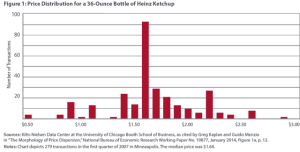Understanding the price of ketchup may go a long way towards explaining why mainstream health care reformers gives such bad reform advice.
Per-capita health spending varies a great deal. It varies by geography, it varies by health status, it varies by demographics, and it varies by individual patient characteristics. Academics and government officials decry this variation. They think that health care spending and utilization should be the same across the United States. Despite ritual hand waving about the importance of clinical differences, their policy recommendations generally attribute variation to inefficiency, overuse, and waste.
Systems controlled by central planners prize administrative simplicity. Everything is standardized in order to reduce complexity and clients must adapt to the system. The result is fewer choices, higher costs, and tremendous administrative friction.
Private markets, on the other hand, celebrate diversity by tailoring products, prices, and individual contractual arrangements to fit the client.
In Colorado, the legislature gave the All-Payer Claims Database rights to everyone’s medical records because influential health policy experts claimed that having information on everyone’s treatment would allow them to identify best practices and reduce spending variation. The Division of Insurance works hard to standardize regional pricing of health coverage even if it means higher premiums in lower income areas. At the national level, Obamacare standardized insurance to reduce variation, promotes comparative effective research to standardize treatment, and subsidizes Accountable Care Organizations to standardize the structure of medical practice.
Mainstream state health policy would be a lot less harmful if its adherents would stop trying to squash normal price and product variation and start thinking about how to give patients the power to control costs by controlling who gets paid for providing actual medical care.
Here’s the variation in average cost per service for MRIs done at the 21 highest volume MRI facilities in Colorado in 2012:
(Click to enlarge)

Here’s a chart from the Federal Reserve Bank of Richmond’s July 2015 Economic Brief showing price variation in 279 purchases of a 36-ounce bottle of Heinz Ketchup in Minneapolis in the first quarter of 2007. If ketchup varies this much, why shouldn’t MRIs?
(Click to enlarge)

Linda Gorman directs the Health Care Policy Center at the Independence Institute, a free market think tank in Denver.







